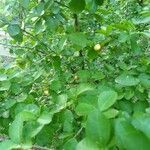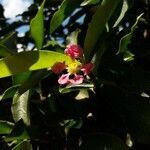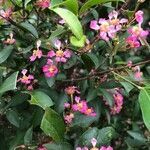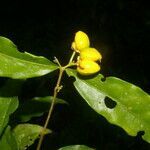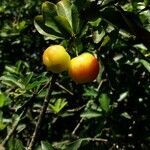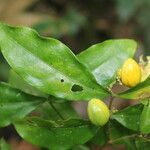Prostrate shrub to small tree 1-3(-10) m tall; young branches green, sparsely strigillose, becoming glabrous, smooth or with prominent lenticels. Leaves char-taceous to sub-coriaceous, ovate-lanceolate to elliptic-lanceolate to ovate, acu-minate or rarely acute at apex, acute to cuneate or rarely rounded at base, (2-)3-7.5(-11) cm long, (1-)1.5-4(-5.5) cm wide; petioles glabrous or sometimes strig-illose when young, (1-)1.5-2(-3) mm long; stipules free, green or reddish, strig-illose when young, becoming glabrous, subulate, 0.5-1 mm long. Inflorescence (2-)4-6(-8)-flowered, pedunculate, umbel-like, rarely raceme-like panicle, 1.5-3(-4) cm long; common peduncle slender, green or reddish, strigillose or rarely glabrous, (2-)5-12(-25) mm long; flowering peduncles green, glabrous or some-times sparsely strigillose, (2-)3-5(-7) mm long; bracts 1-1.5(-2) mm long, brac-teoles 0.5-1 mm long; pedicels green, glabrous or nearly so, (5-)7-11(-15) mm long, sometimes with small malpighiaceous bristles at tip forming a collar below the sepals. Flowers (1-)1.3-1.8(-2) cm diam.; buds (3-)4-5(-6) mm diam., un-keeled; sepals strigillose in bud, becoming glabrous or nearly so, glands 6, 1.5-2.5(-3) mm long, about 3/4 as long as the sepals, rarely glands 7-10 but extra glands very small; posterior petal (6-)6.5-9.5(-11) mm long, limb sometimes sharply reflexed, lateral petals (5-)5.5-7(-8.5) mm long; anterior petals (4-)5.5-6.5(-8) mm long; androecium actinomorphic, all filaments filiform, equal in thick-ness or nearly so, straight, (2-)2.5-3(-3.5) mm long; anthers about equal in size or lateral anthers slightly larger than the rest, 0.8-1.2 mm long; pollination gap 0.5-1 mm long; gynoecium actinomorphic; styles (1.5-)2-2.5(-3) mm long, apex obtuse or truncate; ovary unlobed, long. Fruit pyramidato-globose, usually smooth and unlobed, 1-1.5 cm diam.; pyrenes ovoid, 7-10 mm long, 5-7 mm wide; dorsal wing entire, ca. 1 mm wide, lateral wings undeveloped, margin tuberculate or verrucose, intermediate wings absent.
More
A small evergreen tree or shrub. It grows up to 5-7 m high. It often has several trunks. The branches are spreading and often drooping. The leaves are opposite and oval to sword shaped. They are 2-8 cm long by 1-4 cm wide. They can be wavy along the edge. They are dark green and glossy. The leaf stalk is short. The flowers have both sexes. The flowering stalks are short with 3-5 flowers. The flowers are 1-2 cm across. They are pinkish red. The fruit is bright red. It is 1-2 cm across and has several small seeds. The fruit resemble a common cherry. But is has 3 grooves and 3 seeds. The fruit are carried on the outside of the tree. The seeds are triangle shaped.
Shrubs or small trees, 1–6 m. Leaf blades narrowly to broadly elliptic or ovate, larger blades 3–10 × 1.5–5 cm, apex usually acuminate, occasionally acute, surfaces glabrous or bearing a few fine, straight, appressed hairs. Inflorescences 1.5–3(–3.5) cm, (3–)4–10(–12)-flowered. Flowers: petals pink or pink and white or lavender-pink; anthers glabrous; ovary glabrous; styles nearly straight, parallel or divergent distally, ± alike. Drupes 7–13 mm diam., spheroid. 2n = 20 (Costa Rica).
The fruit are eaten fresh or used in juice. They can be used for wine. They can be used in jellies, jams and preserves. The sauce or puree can be used as a topping for cakes, puddings, ice cream or sliced bananas. Caution: Acerola can produce an allergic reaction similar to that of latex.



